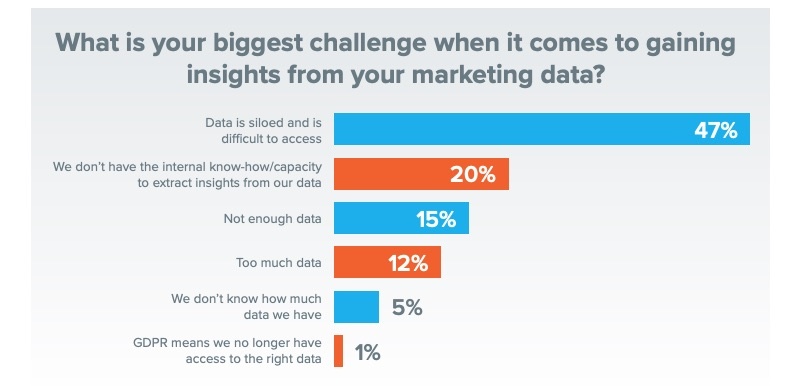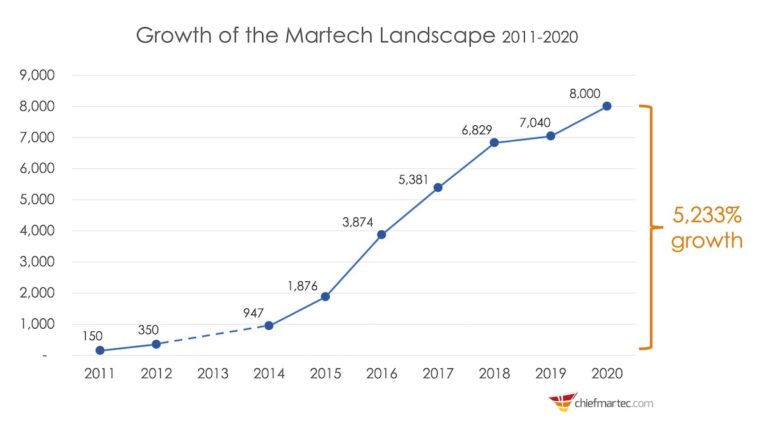
According to Treasure Data’s State of the Customer Journey report, 47% of marketers say that silos are their biggest problem when it comes to gaining insights from data.

A further 20% reveal they don’t even have the knowledge or capacity to extract insights from their data. Both of these issues can be solved by prioritizing effective data management to break silos down and expose valuable insights. Here’s everything you need to know about what data silos are, how they come to be, their impact on marketing, and how to get rid of them.
A data silo is a group of organizational data available to one person or internal team that exists in isolation. While data silos typically create problems for IT, administration, HR, sales, and other departments, nobody is more acutely affected than those in marketing. Data silos make it impossible to have a transparent view of performance and will inevitably create efficiency issues, make collaboration increasingly difficult, and prevent key insights from surfacing that could inform revenue generation opportunities.
Marketing teams are facing a new, very modern challenge as siloed data begins to seriously hinder their capacity to execute effective analyses. That’s because key developments in the field over the past few years have made silos more prominent and destructive than ever before. Here’s why:
More marketing channels and platforms
Today, marketing channels aren’t as simple as online and offline. Now there’s television, radio, mail, and newspapers, all paired with a growing number of digital channels including search, social media, email, messaging, apps, display, and more.
There are also more platforms that allow marketers to reach niche audiences, such as emerging social media giants like Snapchat and TikTok. YouTube has also evolved into a relevant search engine for marketers to target. Each of these platforms offers its own analytics capabilities, siloing marketing performance data more voluminously.
More relevant data
With more platforms comes more relevant audience data marketers can use to improve targeting and campaign optimization. Audience demographics, behavioral insights, and interests from social media and search can inform campaign targeting across disparate channels. Marketers can get a broader picture of audience demographics and habits from third-party data platforms. There’s also a new stream of location data derived from mobile and wearable devices. These new data sources are creating costly silos that didn’t exist even a decade ago.
More tools to manage all of the above
According to Scott Brinker’s MarTech Landscape Supergraphic, the number of marketing tools available has grown from 150 as of 2011 to 8,000 in 2020:

The growth in marketing channels has called for an increase in the number of tools needed to manage them and monitor performance. Rather than helping aggregate marketing data, more tools often just create more silos.
Many companies end up with siloed data by accident. However, few seem in a hurry to fix the issue. This is likely because they don’t fully understand the hugely negative impact data silos have.
1. Wasted time
Data silos don’t completely prevent employees from accessing different data sets, they just make it challenging to do so. Teams can waste countless hours analyzing data only to realize later they need additional information from another analytics source. Then they have to find where the data is located, request access to it, wait for it to arrive, then start analysis again. There’s also the unhappy and lengthy task of stitching different reports together. When siloed data sets need to be integrated, your team likely ends up spending the majority of their time on consolidation instead of tracking performance and optimizing strategy.
2. An incomplete view of performance data
With a multi-channel marketing strategy, you have numerous siloed analytics tools offering relevant performance insights, such as Facebook Analytics, Google Analytics, Bing Analytics, call tracking software, email marketing analytics, etc. This makes it near impossible to get a comprehensive view of how your campaigns work together to reach your marketing goals. Once you’re able to integrate all data and performance analytics, you become empowered to expose new opportunities to drive efficiency, growth, and revenue.
3. Lower data quality and confidence
It’s not uncommon for teams to use different tools and strategies to store and analyze data. The longer data is siloed this way, the more inconsistent and potentially inaccurate it will become. People working on independent marketing initiatives may miss important data streams or accidentally consolidate similar data categories that should remain separate. Some may also end up working with older versions of the same data. Poor data quality can lead to very different analyses, which decreases everyone’s confidence in the accuracy of reporting.
4. Wasted resources
The growing amount of marketing channels and relevant audience data has caused most marketers to expand their MarTech stack to manage data streams, analyze them, and implement their marketing strategies. This means spending more money, time, and resources on different technologies. Storing all your marketing data in a centralized location and analyzing it from there saves significant resources that were necessary when data was siloed.
5. Limited cross-team collaboration
Data silos create difficulties for teams needing to collaborate. Each internal organization is forced to work with their own data to derive their own insights to make decisions. This makes it tough for individuals to share their vision and goals. Rather than working together, teams often miscommunicate and can end up working in competition to reach business goals.
Once you understand the negative impact data silos have on your business, you’re ready to investigate different approaches to fix the problem. Here are some strategies you can use to start integrating your data.
1. Change your company culture
Breaking down silos isn’t just about having systems in place to aggregate data. You also need understanding and buy-in from people who use data at all levels of your business. Even if you use a data management platform, it’s easy for team members to create silos again if the company culture doesn’t change.
When addressing the issue, start by communicating why data silos are so damaging to your marketing initiatives. Make your goal to move marketing data to a single source of truth clear to employees. Leaders can also take steps to encourage the kind of cross-platform performance analyses that are only possible with consolidated data.
2. Invest in a holistic third-party platform
As opposed to looking for solutions to help you integrate data on your own servers, you can invest in a third-party platform to manage it all. Intelligent platforms like Basis can help to unify all your business data in one place, including from Facebook, Google, Bing, your call center platform, offline data sources, and other channels.
What sets our software apart from other data management solutions is that it also has native analysis features. So not only can users access marketing data from a centralized location, they can use the same tool to uncover insights, create visuals and reports, and share these with internal teams. When everyone uses the same platform to store data and create reports, it’s easy to update analyses based on the latest insights, add in new relevant streams of data when necessary, and collaborate effectively.
3. Set data governance standards
Once you centralize your data, it’s a good time to set governance standards to ensure it’s used properly to avoid creating new silos. This is easy enough to do. Employees may use some data and analysis features but don’t necessarily need access to all your marketing data. You can use your software to set up account levels and permissions to grant levels of access to different employees. It’s also possible to put rules in place for how employees can use and analyze data. Otherwise, you’re likely to get instances of employees exporting data to spreadsheets for analysis, creating new silos again.
The customer journey is becoming more complex year after year, with new touchpoints online and offline that influence decision-making. This provides a wealth of marketing data to go along with relevant operational and sales data you can use to optimize all sorts of processes. Harnessing a wide variety of data types from different sources means that database management is now a top priority for businesses small and large. The negative impact of data silos will only grow if leaders continue to ignore this need.